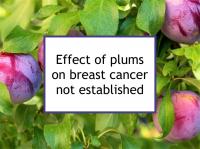Plums (Prunus domestica) are a good dietary source of vitamin A (through its beta-carotene content) and vitamin C and various anthocyanins (such as glycosides of cyanidin, as well as peonidin). Plums also incorporate chlorogenic acid, rutin, ursolic acid and fiber, in addition to some potassium, magnesium and boron.
Plums have been shown to possess antioxidant, neuroprotective and anti-inflammatory properties. Chlorogenic acid has been shown to decrease anxiety in mice. Laboratory rats that drank plum juice had improved working memory in a water maze in one experiment. Plums have substantial bile acid binding potential, which has been associated with lower cholesterol and lower risk of heart disease and cancer.
Dried plums (prunes) are a better source of soluble fiber, ursolic acid and vitamin K than plums. Prune consumption has been shown to improve bone health by improving bone density and strength. However, much of the anthocyanin content of plums is lost when they are dried to produce prunes.
Breast cancer-related effects of eating plums
Plum extract has been shown to decrease the proliferation of breast cancer cells. Plum extract also has been shown to induce apoptosis and reduce viability of human liver cancer cells. Plum consumption has been found to be associated with reduced risk of head and neck cancer. Plum flavonoid glycoside rutin has been demonstrated to reduce cisplatin-induced cardiac and kidney damage in rats.
Purple and dark red plums contain anthocyanins, including cyanidin-3-glucoside, which has been shown to possess both chemopreventive and chemotherapeutic activity and to enhance the treatment effects of trastuzumab (Herceptin). Cyanidin-3-glucoside has also been demonstrated to heighten the efficacy of the cisplatin.
Additional comments
Non-organic plums must be washed thoroughly to remove pesticide residue. Anthocyanin and phenolic content and antioxidant activity is higher in plums with dark skin and flesh than in lighter colored plums, and is also higher in the peels than in the flesh of plums.
Sources of information provided in this webpage
The information above, which is updated continually as new research becomes available, has been developed based solely on the results of academic studies. Clicking on any of the underlined terms will take you to its tag or webpage, which contain more extensive information.
Below are links to 20 recent studies concerning this food and its components. For a more complete list of studies, please click on plum.
